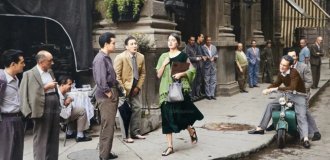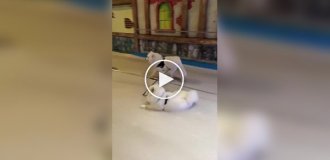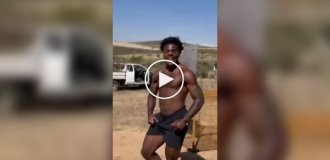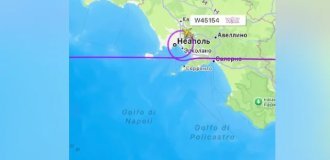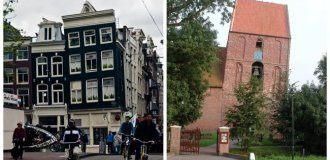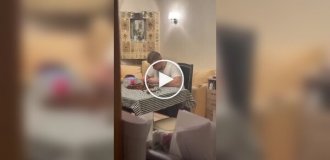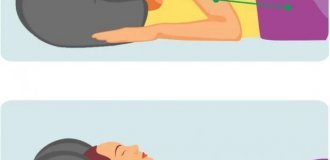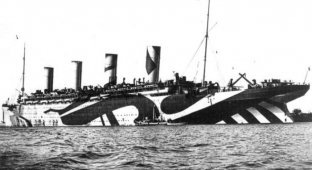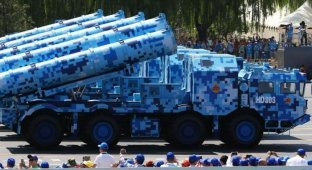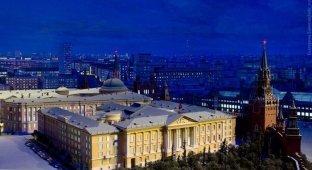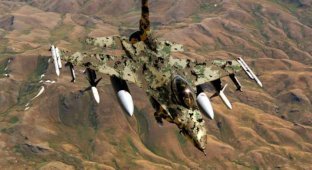“Many known types of camouflage can easily make one clearly visible object appear as two, two objects as three, and so on.”
Roy Behrens, author of the book "Ship Shape" about the history of experiments with Dazzle camouflage
The pattern called Dazzle, which can rightfully be called a pioneer among camouflage patterns, was developed not to camouflage the very object on which it will be applied, but to prevent the enemy from being able to visually determine the size, shape, direction and speed of moving equipment. Most often, "glitter camouflage", as it is sometimes called, was applied to ships and aircraft, using contrasting colors intertwined with each other. Its other name - Razzle Dazzle - is translated from English as “turmoil” and quite clearly describes the effect it produces.

1. Advertising poster for the Cunard Line shipping company, 1918. 2. American battleship USS California, 1944. 3. Schematic diagram of the design of the battleship. 4. Painting “Dazzle-ships in Drydock at Liverpool” by English artist Edward Wadsworth, 1919
Dazzle as a type of camouflage pattern made sense only in those days when the military did not yet have powerful radars that could easily determine the size, speed and distance to the object being examined. This special coloring could confuse a keen-eyed gunner, causing only confusion. One can compare such tactics with the false eyes of some species of fish or butterflies - with such a pattern, and even from a short distance, determining where the bow of the ship is and where the stern is was not such an easy task for the enemy.

The inventor of this camouflage (as well as its name) is considered to be the English artist and illustrator Norman Wilkinson, who served on one of the Royal Navy submarines during the First World War. At that time, German submarines were too easily able to destroy British cruisers - the main combat unit turned out to be practically unarmed against submarines. It got to the point that in one day the Germans could sink up to eight British ships. Thinking about how to hide a huge ship from the view of a periscope, Wilkinson came to the idea that there was no need to hide the object itself when you could simply confuse the enemy who was preparing to strike.

It is worth noting that it was during that period of the First World War that camouflage began to take on massive circulation and began to be used by the troops of all sides involved in the war. Thus, the Germans painted the steel helmets of their infantry with spots, and the Russian troops decorated their armored vehicles with multi-colored amoebas.

It is also worth knowing about the connection of this pattern with avant-garde art - it is believed that when Norman Wilkinson came up with the Dazzle camouflage, he, among other things, was inspired by the early works of cubist artists who used chopped contrasting geometric shapes to give the canvas volume. Similar in meaning techniques can be found in the paintings of many of them, for example, Pablo Picasso (in the image below is his painting “Harlequin” from 1909).


By the way, the zebra's camouflage pattern works on the same principle as the dazzle - it confuses the predator by masking the direction of movement. Several such animals, gathered in a group, cause the effect of random movement, even being practically motionless.

The result of the developments of Wilkinson and his team of artists was the ocean liner HMS Alsatian, which was repainted in Dazzle in August 1917 after testing this type of camouflage on mock-ups. The experiment was successful, and British troops began to almost everywhere introduce this color scheme to camouflage large ocean liners. Wilkinson, in turn, began working with the US Army, and after the end of the First World War he became president of the Royal Institute of Painters in Water Colours.

During World War II, Dazzle was increasingly used by American and German troops, but at the same time this moment is considered the time of death of the “brilliant disguise”. By this time, special binoculars, radars and other equipment were already becoming popular, making it possible to easily determine the distance to an object, its size and trajectory of movement. In 1942, the British Army adopted the Admiralty Intermediate Disruptive Pattern, which was a Dazzle modified by artist Peter Scott - it had more rounded shapes of the elements and included more colors, for example, shades of blue.


A single-seat American P-51 Mustang fighter jet painted in a Dazzle camouflage. Used during World War II

Today Dazzle is practically not used, and the most common example of its use is the Austrian traffic cameras that record the speed of cars: no reckless driver at high speed will be able to notice a camera painted in this way. In addition, this drawing appeared on the cover of the fourth studio album of Orchestral Manoeuvres in the Dark, “Dazzle Ships”.

The development of technology has put an end to this type of camouflage. Or rather, on its military use: it was no longer possible to deceive optical instruments in this way. But Razzle Dazzle was immediately picked up by the post-war generation - this type of camouflage is still relevant and is often used in the creation of youth clothing lines.

And here is one of the paintings of Norman Wilkinson himself. As you can see, the artist was not a cubist at all, preferring to work in more traditional styles. This painting, created in 1915, is called "Beach in the Dardanelles with Soldiers Unloading Medical Supplies."

The best artists of their time were convened to develop the design. Each ship had its own individual livery, which was designed by Abbott Thayer, Maximilian Toch, Edward Wadsworth, Everett Warner and many others. Actually, most of the surviving ships could easily be sent to the Museum of Modern Art.















